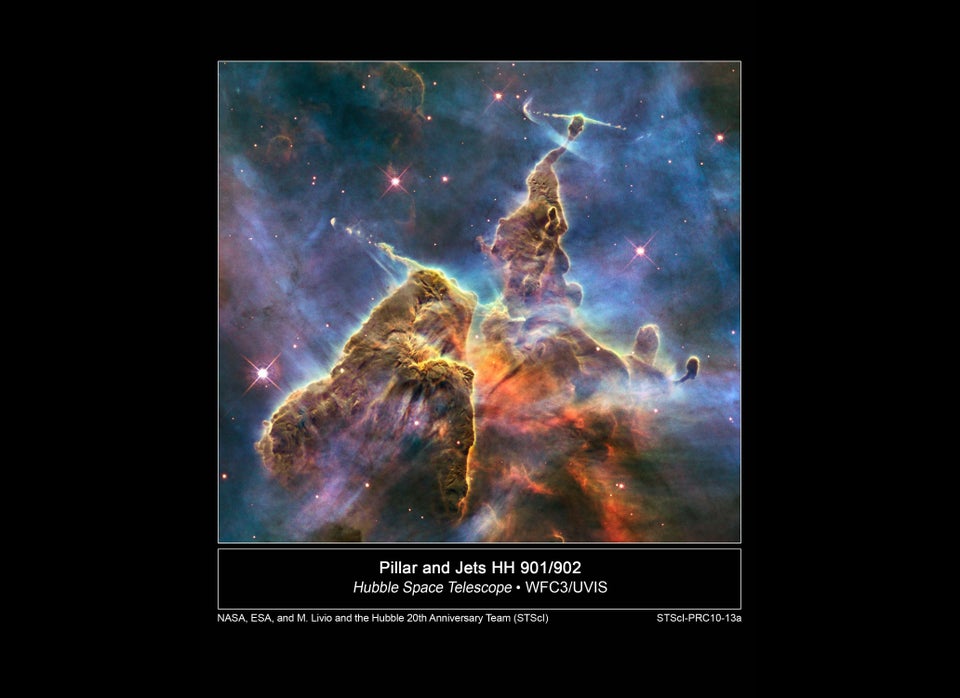Brilliant bursts of star formation in distant dwarf galaxies seen by NASA's Hubble Space Telescope could reveal new information about the early history of the universe, scientists say.
Galaxies churn out new stars all the time, but most of the universe's stars formed between two and six billion years after the Big Bang (which occurred 13.8 billion years ago). The new Hubble observations capture the prolific dwarf galaxies, which are known as "starburst galaxies," during this dramatic epoch, researchers said. You can watch a video explaining the new dwarf galaxy observations above.
"We already suspected that dwarf starbursting galaxies would contribute to the early wave of star formation, but this is the first time we've been able to measure the effect they actually had,"study lead author Hakim Atek, of the École Polytechnique Federale de Lausanne in Switzerland, said in a statement.
"They appear to have had a surprisingly significant role to play during the epoch where the universe formed most of its stars," Atek added.
The distant dwarf galaxiesthat the Hubble telescope observed are forming stars so quickly that they can double the number of stars they hold in just 150 million years. Normal galaxies take 1 to 3 billion years to do this, researchers said.
Starburst galaxies are relatively rare; researchers think these galaxies generally require a powerful event, such as a supernova explosion or galaxy merger, to get kicked into star-forming gear.
Hubble observed the dwarf galaxies using its Wide Field Camera 3 (WFC3) instrument, which captures images in a wide range of wavelengths. In the new study, infrared light proved key to illuminating the faraway starburst galaxies.
WFC3 also has a prism, which splits light into its constituent wavelengths. The spectroscopy mode of the camera produced the images, in which each galaxy appears as a rainbow streak. Scientists analyze the galaxies' spectra to estimate how far away they are from Earth and determine their chemical composition.
Previous studies of starburst galaxies had focused on nearby or large galaxies, leaving out the faraway, ancient dwarfs, which are more difficult to observe, researchers said.
The iconic Hubble Space Telescope has been snapping pictures of the universe since 1990 and is part of NASA's "Great Observatories" project.
Follow Kelly Dickerson on Twitter. Follow us @Spacedotcom, Facebook or Google+. Originally published on Space.com.
Copyright 2014 SPACE.com, a TechMediaNetwork company. All rights reserved. This material may not be published, broadcast, rewritten or redistributed.
Support HuffPost
Our 2024 Coverage Needs You
Your Loyalty Means The World To Us
At HuffPost, we believe that everyone needs high-quality journalism, but we understand that not everyone can afford to pay for expensive news subscriptions. That is why we are committed to providing deeply reported, carefully fact-checked news that is freely accessible to everyone.
Whether you come to HuffPost for updates on the 2024 presidential race, hard-hitting investigations into critical issues facing our country today, or trending stories that make you laugh, we appreciate you. The truth is, news costs money to produce, and we are proud that we have never put our stories behind an expensive paywall.
Would you join us to help keep our stories free for all? Your contribution of as little as $2 will go a long way.
Can't afford to donate? Support HuffPost by creating a free account and log in while you read.
As Americans head to the polls in 2024, the very future of our country is at stake. At HuffPost, we believe that a free press is critical to creating well-informed voters. That's why our journalism is free for everyone, even though other newsrooms retreat behind expensive paywalls.
Our journalists will continue to cover the twists and turns during this historic presidential election. With your help, we'll bring you hard-hitting investigations, well-researched analysis and timely takes you can't find elsewhere. Reporting in this current political climate is a responsibility we do not take lightly, and we thank you for your support.
Contribute as little as $2 to keep our news free for all.
Can't afford to donate? Support HuffPost by creating a free account and log in while you read.
Dear HuffPost Reader
Thank you for your past contribution to HuffPost. We are sincerely grateful for readers like you who help us ensure that we can keep our journalism free for everyone.
The stakes are high this year, and our 2024 coverage could use continued support. Would you consider becoming a regular HuffPost contributor?
Dear HuffPost Reader
Thank you for your past contribution to HuffPost. We are sincerely grateful for readers like you who help us ensure that we can keep our journalism free for everyone.
The stakes are high this year, and our 2024 coverage could use continued support. If circumstances have changed since you last contributed, we hope you’ll consider contributing to HuffPost once more.
Already contributed? Log in to hide these messages.
